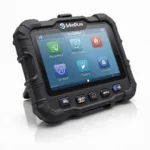The OBD2 code P0118 signals a problem with your vehicle’s engine coolant temperature (ECT) sensor circuit, specifically indicating a high voltage reading. This code is a common issue faced by car owners, and understanding its implications can save you time and money on unnecessary repairs.
What Does the P0118 Code Mean?
Your car’s Engine Control Module (ECM) relies heavily on the ECT sensor to regulate various engine functions. This sensor continuously monitors the engine coolant temperature and sends this data to the ECM. The P0118 code is triggered when the ECM detects a voltage signal from the ECT sensor that’s higher than expected for a specific period, usually exceeding the manufacturer’s preset threshold. This usually indicates a problem within the sensor circuit itself or related wiring.
Causes of OBD2 Code P0118
The P0118 code can stem from a variety of issues, ranging from simple to complex:
- Faulty ECT Sensor: The most common culprit is a malfunctioning ECT sensor itself. Over time, the sensor can degrade, providing inaccurate readings to the ECM.
- Wiring Problems: Damaged, corroded, or loose wiring within the ECT sensor circuit can disrupt the voltage signal, leading to the P0118 code.
- Coolant Issues: Low coolant levels or the use of incorrect coolant can impact the sensor’s readings.
- Faulty Thermostat: A stuck-closed thermostat can cause the engine to overheat, potentially damaging the ECT sensor.
- Damaged ECM: In rare cases, a faulty ECM might misinterpret the sensor’s signal, although this is less likely.
Symptoms of a P0118 Code
While the check engine light illuminating on your dashboard is the most obvious sign, other symptoms might accompany the P0118 code:
- Overheating Engine: A malfunctioning ECT sensor can lead to inaccurate temperature readings, resulting in engine overheating.
- Poor Fuel Economy: The ECM, working with inaccurate data, might inject more fuel than necessary, decreasing fuel efficiency.
- Difficulty Starting: A faulty ECT sensor can disrupt the engine’s cold start routine, making it harder to start, especially in cold weather.
- Rough Idling or Stalling: The engine might idle rough or stall due to the incorrect air-fuel mixture caused by the inaccurate temperature readings.
Diagnosing the P0118 Code
Accurately diagnosing the root cause of the P0118 code requires a systematic approach:
- Read the Code: Use an ECT OBD2 scanner to read the trouble code.
- Visually Inspect: Check the ECT sensor, wiring, and connector for any visible damage, corrosion, or loose connections.
- Test the Sensor: Use a multimeter to test the ECT sensor’s resistance and compare it to the manufacturer’s specifications.
- Inspect the Coolant: Ensure the coolant level is adequate and the correct type of coolant is being used.
- Check the Thermostat: Inspect the thermostat’s operation to ensure it’s opening and closing at the appropriate temperatures.
How to Fix the P0118 Code
Depending on the diagnosis, the solution might involve:
- Replacing the ECT Sensor: A faulty sensor will need replacement with a new one.
- Repairing Wiring: Damaged or corroded wires should be repaired or replaced.
- Refilling Coolant: Top off the coolant level with the recommended type.
- Replacing the Thermostat: A malfunctioning thermostat necessitates replacement.
- Consulting a Mechanic: If the issue persists or seems related to the ECM, consult a qualified mechanic for further diagnosis and repair.
Cost of Repairing a P0118 Code
The repair cost for a P0118 code can vary greatly depending on the specific issue and labor costs in your area.
- ECT Sensor Replacement: $50 – $150 (parts and labor)
- Wiring Repair: $100 – $300 (parts and labor)
- Coolant Refill: $20 – $50 (parts and labor)
- Thermostat Replacement: $100 – $300 (parts and labor)
Preventing a P0118 Code
Regular vehicle maintenance is crucial in preventing the P0118 code:
- Routine Coolant Flushes: Adhere to your vehicle manufacturer’s recommended coolant flush intervals.
- Regular Inspections: Regularly inspect the ECT sensor, wiring, and coolant levels for any signs of wear and tear.
- Quality Coolant: Always use the correct type of coolant specified for your vehicle.
Frequently Asked Questions about OBD2 Code P0118
Can I drive with a P0118 code?
It’s not advisable to drive with a P0118 code, especially if the engine is overheating. Driving with this issue can potentially lead to further engine damage.
How long does it take to replace an engine coolant temperature sensor?
Replacing an ECT sensor is usually a straightforward process that can be completed within an hour by a mechanic.
Is the P0118 code serious?
While not an immediate emergency, ignoring the P0118 code can lead to serious engine problems, especially if the engine overheats.
What’s the difference between a P0117 and P0118 code?
Both codes signal issues with the ECT sensor circuit. However, P0117 indicates low voltage, while P0118 indicates high voltage.
Can a bad battery cause a P0118 code?
While unlikely, a severely depleted battery can disrupt the voltage signals within the car’s electrical system, potentially triggering a P0118 code.
For additional information on coolant temp sensor obd2 code issues, you can explore our comprehensive resources. If you need specific guidance on water temperature sensor wire color obd2 gsr, we have detailed guides available.
Need further assistance?
Feel free to reach out to our team via WhatsApp: +1(641)206-8880 or Email: [email protected]. Our dedicated customer support team is available 24/7 to address any questions or concerns you may have.
